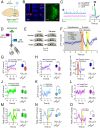Differential attentional control mechanisms by two distinct noradrenergic coeruleo-frontal cortical pathways
- PMID: 33139568
- PMCID: PMC7682591
- DOI: 10.1073/pnas.2015635117
Differential attentional control mechanisms by two distinct noradrenergic coeruleo-frontal cortical pathways
Abstract
The attentional control of behavior is a higher-order cognitive function that operates through attention and response inhibition. The locus coeruleus (LC), the main source of norepinephrine in the brain, is considered to be involved in attentional control by modulating the neuronal activity of the prefrontal cortex (PFC). However, evidence for the causal role of LC activity in attentional control remains elusive. Here, by using behavioral and optogenetic techniques, we investigate the effect of LC neuron activation or inhibition in operant tests measuring attention and response inhibition (i.e., a measure of impulsive behavior). We show that LC neuron stimulation increases goal-directed attention and decreases impulsivity, while its suppression exacerbates distractibility and increases impulsive responding. Remarkably, we found that attention and response inhibition are under the control of two divergent projections emanating from the LC: one to the dorso-medial PFC and the other to the ventro-lateral orbitofrontal cortex, respectively. These findings are especially relevant for those pathological conditions characterized by attention deficits and elevated impulsivity.
Keywords: attentional control; locus coeruleus; norepinephrine; prefrontal cortex; response inhibition.
Conflict of interest statement
The authors declare no competing interest.
Figures





Similar articles
-
Discharge of noradrenergic locus coeruleus neurons in behaving rats and monkeys suggests a role in vigilance.Prog Brain Res. 1991;88:501-20. doi: 10.1016/s0079-6123(08)63830-3. Prog Brain Res. 1991. PMID: 1813931 Review.
-
Effects of selective serotonin and norepinephrine reuptake inhibitors on depressive- and impulsive-like behaviors and on monoamine transmission in experimental temporal lobe epilepsy.Epilepsia. 2016 Mar;57(3):506-15. doi: 10.1111/epi.13321. Epub 2016 Jan 27. Epilepsia. 2016. PMID: 26813337 Free PMC article.
-
Aging disrupts locus coeruleus-driven norepinephrine transmission in the prefrontal cortex: Implications for cognitive and motor decline.Aging Cell. 2025 Jan;24(1):e14342. doi: 10.1111/acel.14342. Epub 2024 Sep 23. Aging Cell. 2025. PMID: 39312903 Free PMC article.
-
Differential effects of chemogenetic inhibition of dopamine and norepinephrine neurons in the mouse 5-choice serial reaction time task.Prog Neuropsychopharmacol Biol Psychiatry. 2019 Mar 2;90:264-276. doi: 10.1016/j.pnpbp.2018.12.004. Epub 2018 Dec 6. Prog Neuropsychopharmacol Biol Psychiatry. 2019. PMID: 30529002
-
Inhibition and impulsivity: behavioral and neural basis of response control.Prog Neurobiol. 2013 Sep;108:44-79. doi: 10.1016/j.pneurobio.2013.06.005. Epub 2013 Jul 13. Prog Neurobiol. 2013. PMID: 23856628 Review.
Cited by
-
Locus Coeruleus Optogenetic Modulation: Lessons Learned from Temporal Patterns.Brain Sci. 2021 Dec 9;11(12):1624. doi: 10.3390/brainsci11121624. Brain Sci. 2021. PMID: 34942924 Free PMC article.
-
Noradrenergic modulation of rhythmic neural activity shapes selective attention.Trends Cogn Sci. 2022 Jan;26(1):38-52. doi: 10.1016/j.tics.2021.10.009. Epub 2021 Nov 16. Trends Cogn Sci. 2022. PMID: 34799252 Free PMC article. Review.
-
Pupil dynamics during very light exercise predict benefits to prefrontal cognition.Neuroimage. 2023 Aug 15;277:120244. doi: 10.1016/j.neuroimage.2023.120244. Epub 2023 Jun 21. Neuroimage. 2023. PMID: 37353097 Free PMC article.
-
Transcutaneous auricular vagus nerve stimulation as a potential therapy for attention deficit hyperactivity disorder: modulation of the noradrenergic pathway in the prefrontal lobe.Front Neurosci. 2024 Dec 4;18:1494272. doi: 10.3389/fnins.2024.1494272. eCollection 2024. Front Neurosci. 2024. PMID: 39697776 Free PMC article. Review.
-
Cerebrospinal fluid and positron-emission tomography biomarkers for noradrenergic dysfunction in neurodegenerative diseases: a systematic review and meta-analysis.Brain Commun. 2023 Mar 29;5(3):fcad085. doi: 10.1093/braincomms/fcad085. eCollection 2023. Brain Commun. 2023. PMID: 37151227 Free PMC article. Review.
References
-
- Miyake A., et al. , The unity and diversity of executive functions and their contributions to complex “frontal lobe” tasks: A latent variable analysis. Cognit. Psychol. 41, 49–100 (2000). - PubMed
-
- Friedman N. P., Miyake A., The relations among inhibition and interference control functions: A latent-variable analysis. J. Exp. Psychol. Gen. 133, 101–135 (2004). - PubMed
-
- Yantis S., “Control of visual attention” in Attention, Pashler H., Ed. (Psychology Press, Hove, England, 1998), pp. 223–256.
-
- Bari A., Robbins T. W., Inhibition and impulsivity: Behavioral and neural basis of response control. Prog. Neurobiol. 108, 44–79 (2013). - PubMed
-
- Whelan R. et al. .; IMAGEN Consortium , Adolescent impulsivity phenotypes characterized by distinct brain networks. Nat. Neurosci. 15, 920–925 (2012). - PubMed
Publication types
MeSH terms
Substances
Grants and funding
LinkOut - more resources
Full Text Sources
Molecular Biology Databases
Miscellaneous

